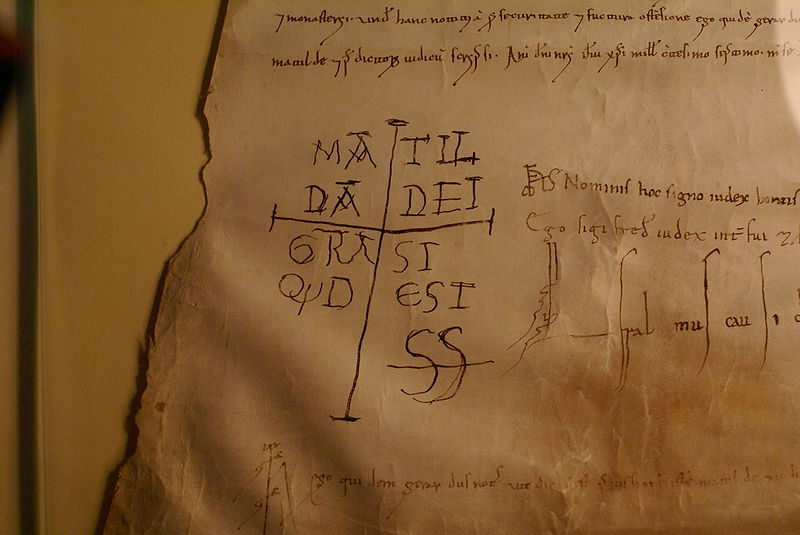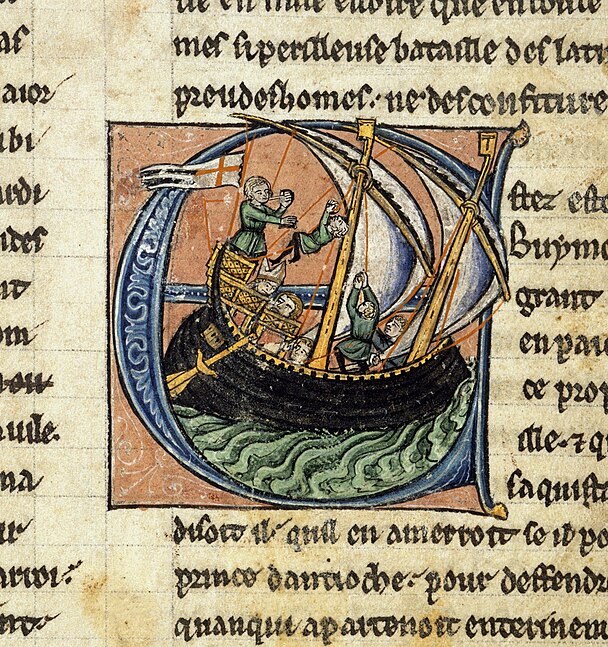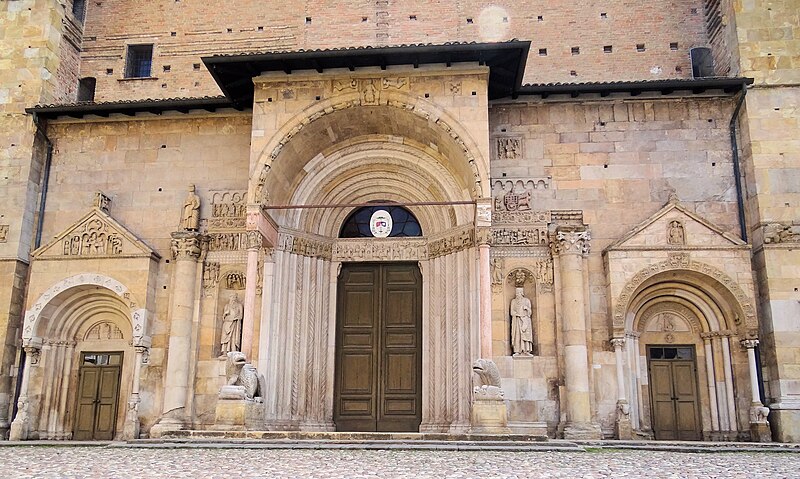 |
| Matilda's signature |
The Reformist Church
Matilda’s
objectives included the election of a reformist pope to replace Gregory and
closing the Alpine passes against further incursions from Germany. The
reformers inability to find a strong candidate to replace Gregory left them
dependent upon Matilda. There was fighting between the reformers and the
traditionalists in Rome; Bernold of Constance reported;
‘At this time much killing,
burning and pillaging was committed between the supporters of Henry and the
vassals of St Peter.’[i]
Matilda’s
triumph at Sorbara enabled her to successfully interfere in internal church
matters. Following the deaths of Henrician supporters within the church, along
with her allies Matilda organised the election of reformist clergy to the sees
of Modena. Reggio and Pistoia. By 1088 the Gregorian radical Bonizo[ii] was elected bishop of Piacenza with the support of the citizenry. Cremona also found itself with a Gregorian bishop when Walter was elected sometime
before September 1086.
 |
| Bishop Diambert (2nd L) |
A number of
clergymen who had supported Henry now saw their way to the truth and light; Archbishop Anselm III of Milan and Bishop Diambert[iii] of Pisa started to modify their
antagonism around 1088. The struggles between the Gregorian reformers and the
traditionalists slowed down the pace of change but Matilda and her allies were
able to ‘strengthen and expand’ their
hold over much of the north and central Italy.
After his
death Gregory had recommended three candidates to succeed him; his first choice
was Anselm of Lucca who was dead by the time elections were held in May 1086
and another of Gregory’s choices, the Abbot of Montecassino was chosen in
Anselm’s place. A divisive figure, Pope Victor III survived in the hot house of
Rome for less than two years despite Matilda’s support. Victor was replaced on
12th March 1088 by Odo of Châtillon, Bishop of Ostia, and a committed reformer who took
the name Urban II.
Marriage Number Two
 |
| Duke Welf of Bavaria |
Before
crossing the Alps Henry undertook a brief campaign to capture Matilda’s lands
in Lorraine. In 1090 Henry crossed the mountain
passes and engaged in reducing Matilda’s castles north of the Po,
while Matilda was entrenching down south of the river waiting for a chance to
counterattack. Bernold of Constance wrote;
 |
| Welf and Matilda |
‘Duke Welf [the Younger] of
Italy incurred much arson and pillaging when King Henry entered Lombardy in
this year, but at the exhortation of his beloved wife. Lady Matilda, he fought
to remain in fidelity to Saint Peter, and to withstand Henry manfully.’[iv]
On 10th
April 1091 Henry’s troops took Mantua after a siege lasting nearly 12 months. Henry then concentrated his
efforts at subduing Matilda’s lands north of the Po, taking the castle of
Manerbio[v].
In the
winter of 1091-2 Matilda’s troops were defeated at the battle of Tricontai at
the hands of Henry’s troops. Welf, recently en-feoffed with the lands her
father had held from the Bishop of Mantua, was probably one of her commanders
at the battle. Matilda had sent a force over the Po to hunt for Henry. It has
been surmised that Matilda’s force were betrayed by Hugh of Maine, Welf’s uncle.
Not long
after their marriage Welf the younger discovered that Matilda had secretly
endowed the church with all her wealth and the couple separated in 1095. Welf
and his father then swapped sides and became allies of the emperor, possibly
hoping that Henry would confirm Welf as his father’s successor as Duke of Bavaria.
Against the Emperor
Despite the
defeats at Mantua and Tricontai Matilda fought on. Nevertheless Henry’s
position had improved; the reformers had lost ground in Germany where a number
of Gregorian churchmen had died along with the anti-Duke of Swabia, Berthold of Rheinfelden.
For his part
Urban was finding it difficult to impose his authority in Rome; the Henrician
Pope Wibert had not been expelled from the city until the summer of 1089; he
then set up shop in Ravenna. By February 1091 he was back inside the walls of
the Vatican while Urban celebrated Christmas outside the city walls. Henry held
court in Mantua over Christmas, staying there until Easter 1092.
| Carpineti |
In the June
Henry started a campaign against Matilda; seizing towns and fortresses
throughout the lands south of the Po. He took the castles Montemorello and
Montealfredo[vi]
and captured Matilda’s standard bearer Gerard. Henry then moved on to Monteveglio[vii], where his ambitions were stymied by
both the rugged mountains and the stubborn defence. Wibert arrived in late
summer with reinforcements.
In early
autumn Henry decided to attempt to end the status quo by offering to return to
Matilda all her lands and raise the siege at Monteveglio if she would recognise
Wibert as pope. Matilda held a conclave at Carpineti to consider the proposal, which she herself did not wish to accept. Many
of Matilda’s supporters, including Bishop Heribert of Reggio, were weary of the
seemingly endless war with the emperor. Despite this the council eventually
agreed to refuse Henry’s offer.
Another Humiliation At Canossa
Henry now
decided to make another attempt to take Canossa to where Matilda had just
returned. Matilda divided her forces, leaving some of her soldiers to defend
the fortress at Canossa and took the remainder to her fortress at Bianello. It
is likely that Henry was able to field a much larger force than the one that
Matilda had to protect her demesnes.
Henry’s
forces made an unsuccessful attack on Canossa and then regrouped, having lost
the imperial banner. Donizo[viii] wrote;
Having a heart dejected
beyond measure, because he saw that the moment had turned against him.
He did not want to ride that
road, nor even to know if [sic] it,
Not for ten thousand pounds!
The loss of the banner
marked his defeat.
So that henceforth his reputation for losing soldiers
grew.’[ix]
Henry had
hoped to take Matilda prisoner, thus removing his major antagonist. But
continuing his attacks on Canossa left his supply lines open to attack from
Bianello. For her part Matilda was aware of the need to stay out of Henry’s
hands.
Henry’s
decision to retreat was undoubtedly correct from a military viewpoint, but it
did almost irreparable damage to his reputation and from now on Henry’s forces
were to suffer, particularly after Henry left them to their own devices. Matilda
took advantage and over the next few years was able to win back most of the
lands taken from her.
Rebellion
In 1093 Henry
was further humiliated by the transfer of his son Conrad’s allegiance to the reforming arm of the church. Henry was
convinced that Matilda was the cause of Conrad’s conversion. The author of
Henry’s Life wrote;
‘[Conrad] was won over by
the persuasions of Matilda – for whom may not womanly guile corrupt or deceive?
– and joined his father’s enemies.’
 |
| Cathedral at Borgo San Donnino |
Henry
imprisoned Conrad who managed to escape and in July Matilda and her allies
elected him King of Italy[x] and she arranged his coronation in
Milan by Archbishop Anselm. Conrad took up residence in Borgo San Donnino[xi], impeding imperial access to Rome.
Conrad was not alone in his conversion; a number of Henry’s other nobles
followed him into the reformists’ fold.
In 1094
Henry’s wife, Eupraxia of Kiev[xii], left her husband and, like her
stepson, looked to Matilda for her protection. The Annales Stadenses claims that;
‘The queen finally escaped
her guard, came into Italy to that very powerful Matilda and by her escort to
Pope Urban, to whom she sadly related her misfortune.’[xiii]
In March
1095 at the Council of Piacenza, Eupraxia claimed that Henry had
imprisoned her in Verona and had forced her to have sexual intercourse with
other men. Donizo alleged that Matilda sent the men who helped Eupraxia escape
her imprisonment in Verona.
These
personal setbacks and the military missteps after Canossa led to a collapse of
Henry’s authority south of the Alps. Matilda and her allies held all the major
passes across the Alps and Henry was unable to take back control of his lands
in Italy.
Bibliography
The Making
of Europe – Robert Bartlett, Penguin Books 1994
The Military
Leadership of Matilda of Canossa – David J Hay, Manchester University Press
2008
The Holy
Roman Empire – Friedrich Heer, Phoenix Giant Paperback 1995
The Oxford
History of Medieval Europe – George Holmes, Oxford University Press, 2001
Absolute
Monarchs – John Julius Norwich, Random House 2011
The First
Crusade – Steven Runciman, Folio Society 2002
The
Hapsburgs – Andrew Wheatcroft, Folio Society 2004
www.wikipedia.en
[i]
The Military Leadership of Matilda of Canossa - Hay
[ii]
Later made a saint; mutilated and expelled from the city in 1089
[iii]
Or Dagobert
[iv]
The Military Leadership of Matilda of Canossa - Hay
[v]
Between Brescia and Cremona
[vi]
Both castles apparently lying in the mountains to the south of the Via Emilia
[viii]
Author of an epic poem starring Matilda
[ix]
The Military Leadership of Matilda of Canossa - Hay
[x]
Henry later deposed Conrad and had his younger brother Henry elected in his
place, making Conrad more dependent on Matilda
[xi]
Now Fidenza
[xii]
Also known as Adelaide; she was the daughter of Prince Vsevelod of Kiev
and the widow of one of Henry’s nobles
[xiii]
The Military Leadership of Matilda of Canossa - Hay
No comments:
Post a Comment
Note: only a member of this blog may post a comment.